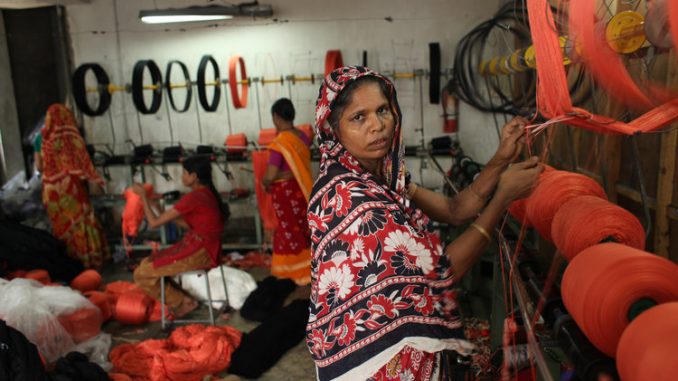
By Sue-Lynn Moses
An estimated 60 million to 75 million people worldwide work in the textile, clothing and footwear industry and around 75 percent of those workers are women. This is hardly breaking news—historically, the garment sector has been one of the most female dominated in the world. But what’s less known is that violence, exploitation, sexual harassment and other abuses of female garment workers is a pervasive problem. And it’s a problem that’s remained rampant even after years of attention to improving supply chains and worker protections.
The good news? Some grantmakers and nonprofits are paying attention.
Last year, the C&A Foundation, Gender at Work, and the Global Fund for Women joined together to launch a new initiative to end gender-based violence and empower female garment workers in Asia.
The joint effort aims to “find, fund and strengthen organizations working to end gender-based violence against women workers in South Asia, with a focus on major apparel sourcing countries including Bangladesh, Cambodia, India, Myanmar and Vietnam.” The initiative and its programs also focus on helping female garment workers learn their rights, discover how they can secure those rights, and determine ways in which they can become leaders for fostering systemic change.
The U.K.-based C&A Foundation pledged €1.5 million to support the initiative’s launch. This is the charitable arm of the international retail clothing chain C&A. The foundation, which is working to change the fashion industry to make it more just, fair and equitable, believes “that to fundamentally transform fashion into a force of good, we must address gender inequality and violence against women.”
A few examples of C&A’s grantmaking in this regard include a four-year, €2.9 million grant to Ashoka for its Fabric of Change partnership and three year, €450,000 grant to Breakthrough for its project building a system responding to sexual harassment and gender-based violence in the workplace and the apparel supply chain. (To get a broader picture of the type of work C&A supports, check out its list of grants.)
The Global Fund for Women, founded three decades ago, is taking the lead in administering the grants for this initiative. The fund focuses on supporting grassroots, local and community organizations around the world that are helping build strong and effective women’s rights movements. In 2016, the fund mobilized over $26 million toward “Rewriting the rules of equity,” and strengthening women’s movements in scores of countries around the world.
While the C&A Foundation and the Global Fund for Women have been involved in the garment worker initiative since the beginning, a relative newcomer—and a big player in the gender equity space—is the NoVo Foundation.
Established in 2006 by Jennifer and Peter Buffett, NoVo “envision[s] a world that operates on the principles of mutual respect, collaboration and civic participation, thereby reversing the old paradigm predicated on hierarchy, violence and the subordination of girls and women.” With its long track record of backing initiatives to reduce gender violence in developing countries, it’s not surprising that less than six months after the garment worker campaign’s launch, the NoVo Foundation announced its plan to invest $1 million over four years in the initiative.
Finally, Indigenous Designs has joined the fold by pledging 10 percent of the sales from its holiday collection to the initiative’s grantmaking activities.
Gender-based violence is often deeply ingrained within the cultures and norms of major garment-producing countries like Bangladesh and India, making this initiative an uphill battle. On the other hand, this is a ripe area for funders to intervene right now, given ongoing scrutiny of supply chains and growing attention to violence and harassment of women. It promises to shine new light on the indignities suffered by millions of female garment workers and perhaps give them a voice they once lacked.
Source: Inside Philanthropy

Leave a Reply